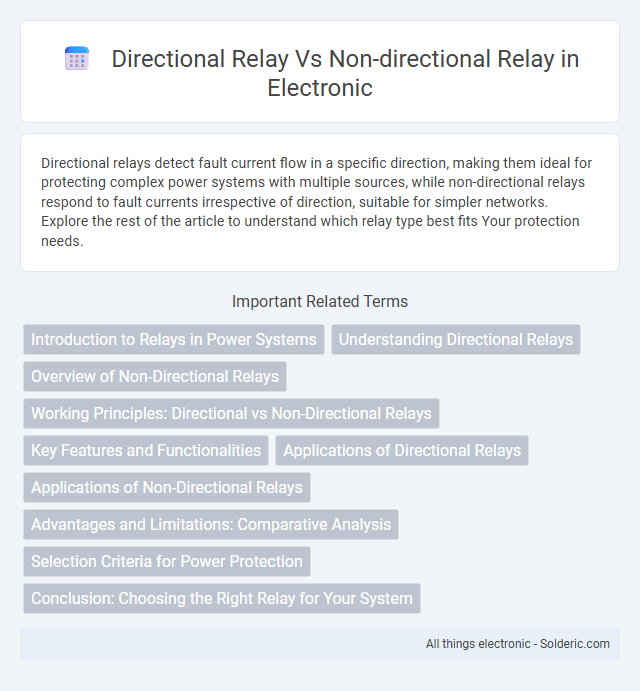Directional relays detect fault current flow in a specific direction, making them ideal for protecting complex power systems with multiple sources, while non-directional relays respond to fault currents irrespective of direction, suitable for simpler networks. Explore the rest of the article to understand which relay type best fits Your protection needs.
Comparison Table
| Feature | Directional Relay | Non-Directional Relay |
|---|---|---|
| Operation | Operates based on fault current direction | Operates based on fault current magnitude |
| Fault Detection | Detects faults in a specific direction | Detects faults regardless of direction |
| Application | Used in complex networks with multiple sources | Used in simple radial systems |
| Components | Requires voltage and current sensing elements | Requires current sensing element only |
| Cost | Higher due to additional components | Lower cost |
| Accuracy | More precise fault isolation | Less precise fault location |
| Complexity | More complex design and setting | Simple design and setting |
Introduction to Relays in Power Systems
Directional relays detect fault current flow direction to isolate faults in specific network sections, enhancing system stability and protection coordination. Non-directional relays respond to fault current magnitude without identifying direction, providing basic fault detection suitable for simpler or radial systems. Your choice between these relays impacts fault management efficiency and overall power system reliability.
Understanding Directional Relays
Directional relays detect current flow direction to isolate faults accurately in power systems, improving system stability and preventing unnecessary outages. Unlike non-directional relays that operate solely on current magnitude, directional relays use voltage and current phase angles to determine fault location, enhancing protective coordination in complex networks. This precise fault discrimination ensures selective tripping, reducing damage and maintaining continuity of service during abnormal conditions.
Overview of Non-Directional Relays
Non-directional relays operate solely based on current magnitude without considering the power flow direction, making them ideal for straightforward fault detection in power systems. They respond to overcurrent conditions regardless of the phase angle between voltage and current, providing fast and reliable protection for equipment. Your power system protection strategy benefits from non-directional relays when directional sensitivity is unnecessary or system conditions are simple.
Working Principles: Directional vs Non-Directional Relays
Directional relays operate by detecting both the magnitude and the direction of current flow, enabling them to isolate faults occurring in a specific direction relative to the relay location. Non-directional relays function solely based on the magnitude of current or voltage without regard to direction, tripping when values exceed preset thresholds regardless of fault location. This directional sensitivity in directional relays is critical for selective fault isolation in complex power systems, whereas non-directional relays provide simpler, faster protection in systems where directionality is not a concern.
Key Features and Functionalities
Directional relays detect fault current flow in a specific direction relative to the relay location, enhancing protection accuracy in power systems with complex network configurations. Non-directional relays respond solely to the magnitude of current or voltage without considering direction, making them suitable for simpler, radial power systems. Your choice depends on system complexity, with directional relays offering precise fault isolation and non-directional relays providing straightforward overcurrent protection.
Applications of Directional Relays
Directional relays are primarily used in power systems to detect fault currents flowing in a specific direction, making them essential for protecting transmission lines, transformers, and feeders where power flow direction matters. These relays enhance system stability and security by isolating only the faulted section without unnecessarily tripping healthy parts of the network. Your power grid benefits from directional relays in complex networks where bidirectional power flows occur, such as interconnected utilities or systems with distributed generation.
Applications of Non-Directional Relays
Non-directional relays are widely used in power systems for overcurrent protection, backup protection, and fault detection in both radial and meshed networks where fault direction is not crucial. They offer reliable operation in situations like transformer protection, motor protection, and feeder fault isolation, making them essential for general protection schemes. Your power system benefits from non-directional relays through their simplicity, cost-effectiveness, and ability to respond quickly to abnormal current conditions regardless of fault direction.
Advantages and Limitations: Comparative Analysis
Directional relays provide precise fault location detection by measuring fault current direction, enhancing system stability and preventing unnecessary outages, while non-directional relays offer simpler, cost-effective protection suitable for radial systems. Directional relays may have higher installation and maintenance costs, require more complex settings, and can be affected by voltage conditions, whereas non-directional relays lack directional sensitivity, potentially causing delayed or inaccurate fault isolation in meshed or looped networks. Your choice depends on system configuration and protection requirements, balancing improved fault discrimination against complexity and expense.
Selection Criteria for Power Protection
Directional relays are selected for power protection in systems where fault current direction is critical, such as in parallel feeders or interconnected networks, ensuring accurate fault isolation and minimizing service disruption. Non-directional relays suffice in simpler systems with clear fault current flow or where direction determination is unnecessary, offering cost-effective and reliable protection. The choice depends on system complexity, fault identification requirements, and coordination with other protective devices.
Conclusion: Choosing the Right Relay for Your System
Selecting the appropriate relay depends on system protection requirements and fault location sensitivity; directional relays are ideal for detecting fault direction in complex network configurations, enhancing selective isolation and minimizing outages. Non-directional relays are suitable for simpler systems where fault direction is less critical, offering cost-effective and reliable protection. Evaluate your electrical network's complexity, fault detection needs, and budget constraints to determine the best relay type for optimal system performance and safety.
directional relay vs non-directional relay Infographic

 solderic.com
solderic.com